Lion850
National Hazard
   
Posts: 517
Registered: 7-10-2019
Location: Australia
Member Is Offline
Mood: Great
|
|
Attempt to make Aluminium Iodide in DCM - runaway reaction!
I previously made aluminium iodide by reacting Al and I2 in water, but the nice yellow product turned darker and darker and is now dark brown. So I
decided to make it in dichloromethane (old reference books mentions it can be made in carbon disulphide which I do not have. What happened:
- 5g Al powder (very fine) in 100ml DCM in a small beaker.
- 6g I2 added, stirred and very gentle heat.
- Solution was initially purple but suddenly turned grey (from the excess Al powder) after 15 minutes, showing the initial 6g I2 was consumed. So far
so good. At this point the DCM reduced to some 80ml due to boiling away. See photo 1.
- Added another 6g I2.
- Solution color turned to purple again but after about 2 minutes it started to boil strongly, even with no heat. Stirring off or on did not seem to
make any difference.
- I realised the reaction was getting out of control and tried to add more DCM in an attempt to cool it down. Did not seem to help.
- DCM was now disappearing rapidly. I tried fast stirring as this usually cools a solution (it sucks in air) but with hindsight this may not have been
a good idea as this would have introduced moisture as well.
- There was a bright flash in the beaker and a huge cloud of slightly sweet smelling white smoke filled the shed. I moved like lightning out of the
door, only popping my head in again to confirm there was no fire.
- After some 5 minutes the smoke dissipated (fortunately it was windy). The beaker was now colored red and yellow, see photo 2. The photo shows more
yellow, but it in fact looked more red.
- The beaker was only slightly hot. The watch glass that was on top to prevent spillage during the stirring was not even dislodged.
- Lifting the watch glass off the beaker caused the contents to start fuming - very cool.
- There was grey sludge in the bottom of the beaker, looked like unreacted Al powder, I scooped up some and dropped it in water where it gave a very
vigorous reaction with bubbling.
- I decided it was not worth recovering any of the products as it was too messed up. So I put the beaker and watch glass into a bucket of water where
it bubbled for a while until the contents was consumed.
I wonder why the first part of the reaction went exactly as it should, but after addition of the second 6g of I2 it quickly ran away. As mentioned I
used DCM and not CS2 as mentioned in the classic references, not sure as that was a factor as the 2 solvents have a similar boiling point as per
Wikipedia.
I want to try again, because the fuming AlI3 is so cool, and I wonder if it is worth trying in Xylene which has a much higher BP. In any event, next
time I will add the I2 in one gram lots and always wait until the solution turned grey before adding more. With only gentle stirring and NO heat. I
will also have the bucket of water very close by to drop in the beaker if necessary.
Lastly, I though the 'smoke' was due to HI reacting with air, but it was not at all irritating - just slightly sweet smelling?
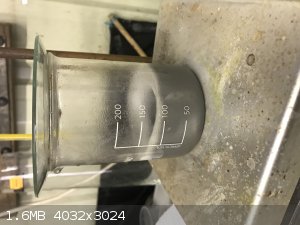 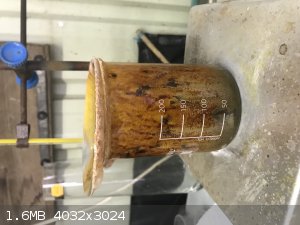 
|
|
|
B(a)P
International Hazard
    
Posts: 1139
Registered: 29-9-2019
Member Is Offline
Mood: Festive
|
|
Did you monitor the temperature after the first addition? Was the sweet odour different to that of DCM?
|
|
|
Lion850
National Hazard
   
Posts: 517
Registered: 7-10-2019
Location: Australia
Member Is Offline
Mood: Great
|
|
Quote: Originally posted by B(a)P  | | Did you monitor the temperature after the first addition? Was the sweet odour different to that of DCM? |
Only by feeling the beaker. But obviously this does not mean much as the DCM boils at such low temp. But it was already close to boiling at that
stage.
I also wondered think more about what happened whether the smoke cloud was mainly the evaporated DCM - did kind of smell similar, and it seemed a
heavy smoke. There was just so much, although this could just be because of the run-away. Certainly was nothing acidic smelling or any smell of
iodine.
|
|
|
B(a)P
International Hazard
    
Posts: 1139
Registered: 29-9-2019
Member Is Offline
Mood: Festive
|
|
In my experience, what you describe seems like the vapour phase DCM.
|
|
|
B(a)P
International Hazard
    
Posts: 1139
Registered: 29-9-2019
Member Is Offline
Mood: Festive
|
|
You can do this reaction in carbon tet, which obviously has a higher boiling point. Maybe the low boiling point of DCM is just to
o much of a limitation to allow the reaction to proceed?
|
|
|
chemplayer...
Legendary
  
Posts: 191
Registered: 25-4-2016
Location: Away from the secret island
Member Is Offline
Mood: No Mood
|
|
DCM has a low boiling point, and the reaction between iodine and aluminium is very exothermic. It will however lull you into a false sense of security
because it takes a while to get going (possibly due to the Al oxide coat formed in air).
One trick will be to use aluminium foil instead which has a lower surface area and will hence slow the reaction down. However the same amount of heat
energy is going to be released overall, and so you're really going to have to use a reflux condenser to recycle the DCM. One issue however will be
that you'll need ice-cold water and a very efficient condenser to prevent the vapour from escaping.
Interestingly if you do this reaction in ethanol, with refluxing, and then distill the product, you can extract a pretty good yield of ethyl iodide
(we did this in a video).
|
|
|
DavidJR
National Hazard
   
Posts: 908
Registered: 1-1-2018
Location: Scotland
Member Is Offline
Mood: Tired
|
|
Once the oxide coating has been removed from the aluminium (by the iodine), will the aluminium react directly with the dichloromethane?
|
|
|
unionised
International Hazard
    
Posts: 5128
Registered: 1-11-2003
Location: UK
Member Is Offline
Mood: No Mood
|
|
Is this surprising to anyone?
It's hardly a new observation.
https://www.sciencedirect.com/sdfe/pdf/download/eid/1-s2.0-0...
https://books.google.co.uk/books?id=4_PJCgAAQBAJ&pg=PA24...
|
|
|
DavidJR
National Hazard
   
Posts: 908
Registered: 1-1-2018
Location: Scotland
Member Is Offline
Mood: Tired
|
|
I thought so.
Try using a non-halogenated solvent.
[Edited on 19-12-2019 by DavidJR]
|
|
|
MrHomeScientist
International Hazard
    
Posts: 1806
Registered: 24-10-2010
Location: Flerovium
Member Is Offline
Mood: No Mood
|
|
I've done a demonstration version of this, where I mixed iodine and aluminum powders together dry. A few drops of water causes a huge exothermic
reaction, producing fire and lots of purple iodine smoke. I'm actually pretty shocked yours lasted as long as it did! I'm surprised that this reaction
can be controlled(ish) with just a solvent.
|
|
|
Lion850
National Hazard
   
Posts: 517
Registered: 7-10-2019
Location: Australia
Member Is Offline
Mood: Great
|
|
Gents thanks for all the comments and suggestions. I'll have another go doing things slightly different and advise on the outcome.
|
|
|
draculic acid69
International Hazard
    
Posts: 1371
Registered: 2-8-2018
Member Is Offline
|
|
Maybe if the reaction was done much more dilute(ie; 1litre of DCM) as in dissolve the i2 in DCM and slowly drip it into a cooled very dilute reaction
mixture of that Al foil and DCM over a 24 HR period or something thus giving time for the formed heat to dissipate between additions.also a water bath
would help absorb some heat.maybe an ice bath but that might stop any rxn from happening.just a thought.
[Edited on 21-12-2019 by draculic acid69]
|
|
|
Lion850
National Hazard
   
Posts: 517
Registered: 7-10-2019
Location: Australia
Member Is Offline
Mood: Great
|
|
Update: Some success!
Yesterday I tried to react Al powder with I2 crystals in Xylene, but nothing much happened, not even after boiling for one hour. There was minimal
color change, and while I did get a red filtrate the yield when boiled down was next to zero, no fuming, and no reaction with water from the sludge
left on the grey ppt.
Today I tried again with DCM and achieved some success:
1) 100ml DCM in 250ml beaker
2) 1 gram of aluminium powder
3) 2 gram iodine. Start stopwatch and start stirring with no heating. Shed ambient temp was around 37 C. Photo 1 shows the beaker after a few minutes,
note the cloud of DCM vapor in the beaker.
4) After 1 hour color changed slightly to dark brown, but still purple splashes on the side of the beaker. Turned on gentle heat and bring to boil
(only a few degrees higher than ambient!)
5) After 1 hr 5 min it suddenly turned grey, being the suspended Al powder, and showing the I2 was consumed.
6) Topped up DCM to 100, add 1g I2, switched off heat and kept stirring. Color dark again.
7) After 1 hr 12 min color turned to grey again. Add 1.2g I2. Beaker stayed a bit hot to touch even with no heat on.
8) After 1 hr 18 min color turned grey again. Add 1.3g I2. Keep going. Color of course back to purple then dark.
9) After 1 hr 30 min color slowly changed to grey with a hint of yellow. Switched off stirring to see what settles out and it appeared still to be Al
powder (or another fine powder) present. Add 1g I2 and keep going.
10) After 1 hr 46 min the color changed to brown-pinkish. Beaker was now feeling the same as room temp. Switch on heat to gentle boil.
11) 1hr 55 min - no color change. Add a tiny bit of Al powder - too small to measure accurately on my scale but maybe 0.1g.
12) 2hr - color a bit more brown.
13) 2hr 10 min - no further color change. See photo 3, final color before filtration.
(** With hindsight at this point I should have added more I2 and kept going as the Al should still have been in excess as per the stoichiometry app I
use).
14) Filter hot. Obtained a lovely wine red filtrate. See photo 4, but with the eye it was more red.
15) What appears to be Al powder on the filter paper. Wash twice with DCM in the filter.
16) Dried the filter paper with the grey sludge direct on the hot plate (cool enough to touch, maybe around 45 C) (see photo) and noticed the
occasional slight fume! Dropped a tiny bit of the grey sludge in a test tube and add some water: a vigorous reaction! Lots of bubbling and the water
got hot. Also heavy fumes in the test tube; it stayed in the tube until it was tilted. Maybe just some DCM still mixed with the sludge. Bottled the
grey sludge, 4g.
17) Boiled down the red filtrate. As the beaker started to boil very low black grains settled out - I wont call them crystals. They gave the same
vigorous reaction with water.
18) When the beaker became very concentrated the contents started to fume in contact with air. I decided to stop boiling down and just bottle the very
thick dark red liquid. Apart from fuming it also gave the same vigorous reaction with water. I poured it into the vial, some solidified on the side,
and it fumed more until the vial was closed. I labelled this my "concentrated" AlI3 solution.
19) There was still more of the sticky "concentrated solution" that solidified in the beaker; this did not fume anymore but still have the same
reaction with water. I dissolved this back in DCM and kept it as my "dilute" solution.
I'm pretty sure I managed to make AlI3. I will redissolve these products in DCM when I get my desiccator and also then make some more to try and
obtain a dry product. But that will have to wait.
The reaction with water and the fuming is really cool for a novice like me. But what is the grey sludge that also reacts very vigorously with water;
some must be unreacted Al powder but what is the rest that appears quite different from the red filtrate and caused the water reaction? A different
iodide salt or possible a more complex Al iodine salt?
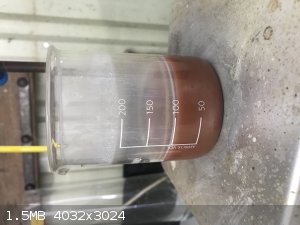 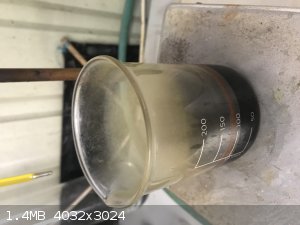 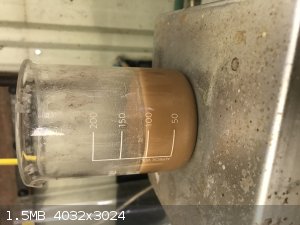 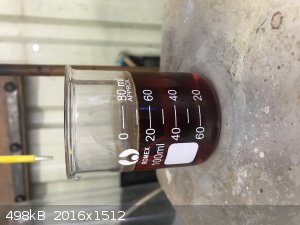  
|
|
|